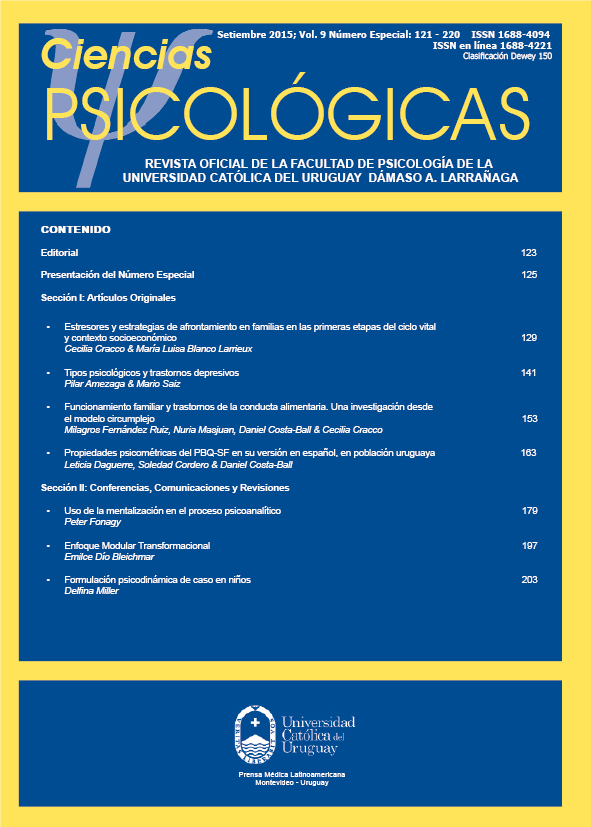FAMILY FUNCTIONING AND EATING DISORDERS. A PERSPECTIVE FROM THE CIRCUMPLEX MODEL
DOI:
https://doi.org/10.22235/cp.v9iEspec.439Keywords:
Family Functioning, Eating Disorders, Circumplex ModelAbstract
The aim of this study was to assess the family functioning of those with a member diagnosed with eating Disorder (ED) and to compare with normative families according with the circumflex model. Sixteen Uruguayan families with a member in rehabilitation were assessed. Results suggest that these families showed in terms of the circumflex model less cohesion and flexibility, and a chaotic, disengaged, enmeshed, rigid functioning with difficulties in communication and less family satisfaction, compared with the normative families. Differences in parents and the rest of the family member perceptions of the family functioning have been found considering the role. These results present to the clinicians the need to work with all the family system in order to approach the ED.Downloads
References
American Psychiatric Association. (2013). The Diagnostic and Statistical Manual of Mental Disorders (5a ed.). Washington, DC.: American Psychiatric Publishing.
Ato, M., López, J. & Benavente, A. (2013). Un sistema de clasificación de los diseños de investigación en psicología. Anales de psicología, 29(3), 1038-1059.
Cohen, J. (1988). Statistical power analysis for the behavioral sciences. New Jersey: Lawrence Erlbaum Associates.
Cook-Darzens, S., Doyen, C., Falissard, B., & Mouren, M.C. (2005). Self- perceived family functioning in 40 French families of anorexic adolescents: implications for therapy. European Eating Disorders Review, 13, 223-226.
Correa, M. L., Zubarew, T., Silva, P., & Romero, M. (2006). Prevalencia de riesgo de trastornos alimentarios en adolescentes mujeres escolares de la Región Metropolitana. Revista Chilena de Pediatría, 77(2), 153-160.
Costa-Ball, D., González Tornaría, M., del Arca, D., Masjuan, N., & Olson, D.H. (2013). Adaptación al Uruguay del Cuestionario FACES IV: Propiedades psicométricas. Ciencias Psicológicas, 7(2), 119-132.
Costa-Ball, D., González Tornaría, M., Masjuan, N., Trápaga, M., Del Arca, D., Scafarelli, L., & Feibuscheurez, A. (2009). Escala de evaluación del funcionamiento familiar –FACES IV-: proceso de adaptación a Montevideo, Uruguay. Ciencias Psicológicas, 3(1), 43-56.
Cruzat, C., Ramírez, P., Melipillán, R., & Marzolo, P. (2008). Trastornos Alimentarios y Funcionamiento Familiar Percibido en una Muestra de Estudiantes Secundarias de la Comuna de Concepción. Psykhe, 17(1), 81-90.
Dancyger, I., Fornari, V., Scionti, L., Wistsky, W., & Sunday, S. (2005). Do daughters with eating disorders agree with their parents perception of Family Functioning? Comprehensive Psychiatry, 46, 135-139.
Espina, A., (1996). Terapia Familiar en la Anorexia Nerviosa. El Modelo Sistémico. En A. Espina y B. Pumar (Eds.), Terapia Familiar Sistémica. Teoría, Clínica e Investigación, (pp. 154-183). Madrid: Fundamentos.
Faul, F., Erdfelder, E., Buchner, A. & Lang, A. G. (2009). Statistical power analyses using G*Power 3.1: Tests for correlation and regression analyses. Behavior Research Methods, 41(4), 1149-1160.
Feibuscheurez, A. (2009). Características del funcionamiento familiar en el que un miembro padece un trastorno de conducta alimentaria. Manuscrito inédito. Montevideo: Facultad de Psicología.
Crispo, R., Figueroa, E., & Guelar, D. (1996). Anorexia y Bulimia. Lo que hay que saber. Buenos Aires: Paidós.
Hernández, R., Fernández, C. & Baptista, P. (2010). Metodología de la investigación (5a ed.). México: Mc Graw Hill.
Holtom-Viesel, A., & Allan, S. (2014). A systematic review of the literature on family functioning across all eating disorder diagnoses in comparison to control families. Clinical Psychology Review, 34, 29-43.
IBM Corporation (2012a). IBM SPSS Statistics (22). Recuperado de http://www-01.ibm.com/software/ es/analytics/spss/
Kouneski, E.F. (2000). The Family Circumplex Model, FACES II, and FACES IIII: Overview of Research and applications. Recuperado de http://www.facesiv.com/pdf/faces_and_circumplex.pdf
Manglio, A.L., & Molina, M.F. (2012). La familia de adolescentes con trastornos alimentarios ¿Cómo perciben sus miembros el funcionamiento familiar? Revista Mexicana de Trastornos Alimentarios, 3, 1-10.
March, J.C., Suess, A., Prieto, M.A., Escudero, M., Nebot, M., Cabeza, E., & Pallicer, A. (2006). Trastornos de la Conducta Alimentaria: Opiniones y expectativas sobre estrategias de prevención y tratamiento desde la perspectiva de diferentes actores sociales. Nutr Hosp, 21(1), 4-12.
Montero, L., & León, O. (2002). Clasificación y descripción de las metodologías de investigación en psicología. International Journal of Clinical and Health Psychology, 2(3), 503-508.
Olson, D.H. (2000). Circumplex Model of Marital and Family Systems. Journal of Family Therapy, 22, 144-167.
Olson, D.H. (2011). FACES IV and the Circumplex Model: Validation Study. Journal of Marital & Family Therapy, 3(1), 64-80.
Olson, D.H., & Gorall, D.M. (2003). Circumplex model of marital and family systems. En F. Walsh, Normal Family Processes (3a ed.) (pp. 514-547). New York: Guilford.
Olson, D.H., Sprenkle, D.H., & Russell, C.S. (1979). Circumplex Model of Marital and Family Systems: I. Cohesion and Adaptability Dimensions, Family Types, and Clinical Applications. Family Process, 18(1), 3-28.
Pardo, A., & Ruiz Diaz, M.A. (2002). SPSS 11. Guía para el análisis de datos. Madrid: Mc Graw Hill.
Ruiz, A., Vázquez, R., Mancilla, J., Viladrich, C., & Castillo, H. (2013). Factores Familiares asociados a los Trastornos Alimentarios: una revisión. Revista Mexicana de Trastornos Alimentarios, 4, 45-57.
Sanz Vázquez, M. (2008a). Escala de Comunicación Familiar. En Equipo EIF, Manual de instrumento de evaluación familiar, (pp. 79-87). Madrid: Ed. CCS.
Sanz Vázquez, M. (2008b). Escala de Satisfacción Familiar. En Equipo EIF, Manual de instrumento de evaluación familiar, (pp. 69-77). Madrid: Ed. CCS.
Selvini-Palazzoli, M., Cirillo, M., Selvini, M.S., & Sorrentino, A.M. (1999). Muchachas anoréxicas y bulímicas. Buenos Aires: Paidos.
Vázquez, R., Ruíz, A., Álvarez, G., Mancilla, J., & Tena, A. (2010). Percepción del funcionamiento familiar de mujeres con trastornos del comportamiento alimentario. Psicología Conductual, 18(1), 105-117.
Vidovic, V., Jures, V., Begovac, I., Mahnik, M., & Tocilj, G. (2005). Perceived family cohesion, adaptability, and communication in eating disorders. European Eating Disorders Review, 13, 19-28.
















